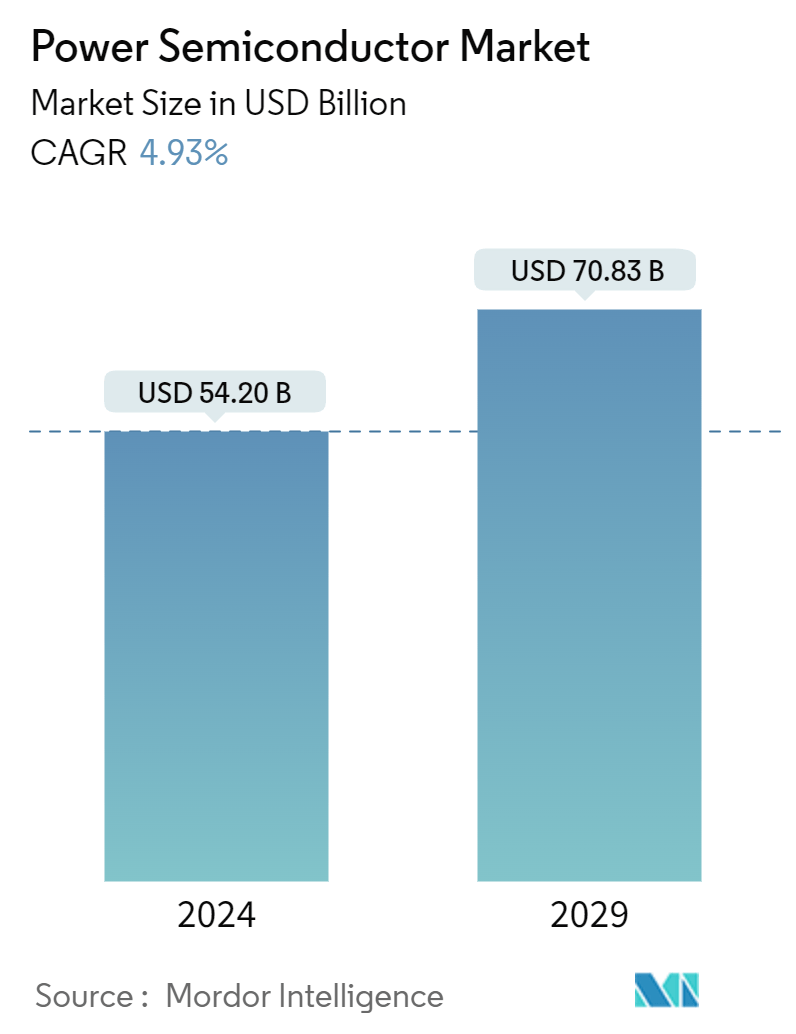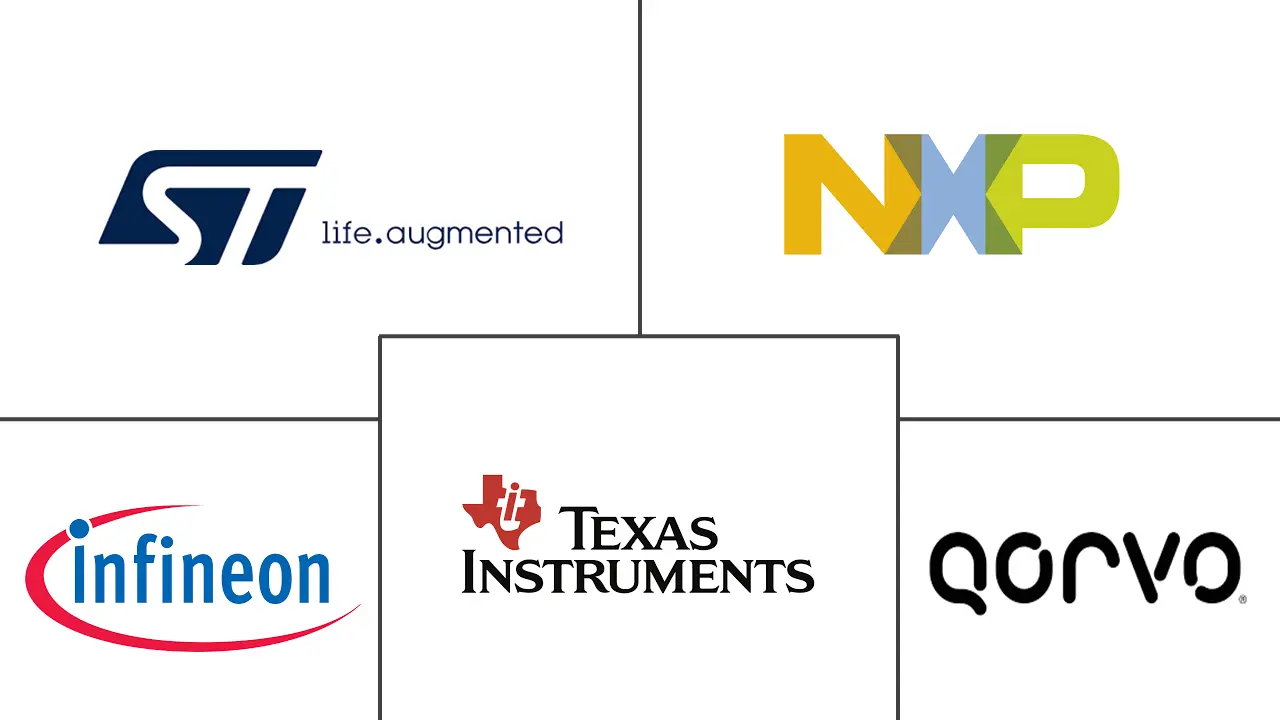Market Size of Power Semiconductor Industry

| Study Period | 2019 - 2029 |
| Market Size (2024) | USD 54.20 Billion |
| Market Size (2029) | USD 70.83 Billion |
| CAGR (2024 - 2029) | 4.93 % |
| Fastest Growing Market | Asia |
| Largest Market | Asia |
Major Players*Disclaimer: Major Players sorted in no particular order |
Power Semiconductor Market Analysis
The Power Semiconductor Market size is estimated at USD 54.20 billion in 2024, and is expected to reach USD 70.83 billion by 2029, growing at a CAGR of 4.93% during the forecast period (2024-2029).
Power semiconductors are designed to handle or process large currents and power, and they are typically categorized as having a rated current of 1A or greater. These devices are used in a wide range of applications, including home appliances, audiovisual equipment, automobiles, etc.
• Power semiconductors have revolutionized the field of electronics and energy management. One of the key advantages of power semiconductors is their ability to improve energy efficiency significantly. By minimizing energy losses during the conversion and control processes, power semiconductors enable systems to operate more efficiently, reducing energy consumption and saving costs. These devices offer higher power density, lower on-resistance, and reduced switching losses, resulting in higher overall system efficiency.
• Moreover, power semiconductors offer higher power density, allowing more power to be handled within a smaller physical footprint, which is beneficial in applications where space is limited, such as electric vehicles and industrial automation. Power semiconductors enable the development of compact and efficient systems by maximizing power output while minimizing space requirements.
• Rapid technological advancement is one of the primary drivers of the surging demand for consumer electronics and wireless communication. The continuous evolution of technology has led to the introduction of innovative and feature-rich devices that have revolutionized the way an individual interacts with the world. Smarter smartphones, ultra-slim laptops, high-definition televisions, and wearable gadgets have become essential tools for both personal and professional purposes. These advancements have enhanced the user experience and contributed to the increasing demand for such devices.
• Silicon wafers are the foundation of power semiconductor manufacturing. These thin, circular discs of crystalline silicon serve as the substrate upon which semiconductor devices are built. Silicon's unique properties, such as its abundance, high thermal conductivity, and excellent electrical properties, make it an ideal material for these applications. The power semiconductor market heavily relies on silicon wafers due to their suitability for high-power applications.
• According to the US Congressional Budget Office, defense spending in the United States is predicted to increase every year until 2033. Defense outlays in the United States amounted to USD 746 billion in 2023. The forecast predicts an increase in defense outlays up to USD 1.1 trillion in 2033. The defense spending would comprise 6% of the country's gross domestic product in 2024, up from 3.9% in 2023 and 2.7% in 2021. The increasing defense budgets globally are expected to offer lucrative opportunities for the growth of the market studied.
Power Semiconductor Industry Segmentation
A power semiconductor is used as a switch or rectifier in power electronics. It plays a crucial role in controlling and converting electrical power in electronic circuits. The market is defined by the revenue generated from sales of various components of power semiconductors like discrete, module, and power IC, using various materials like silicon/germanium, silicon carbide (SiC), and gallium nitride (GaN). They are employed in a diverse range of global end-user industries like automotive, consumer electronics, IT and telecommunication, military and aerospace, power, industrial, and others.
The power semiconductor market is segmented by component (discrete [rectifier, bipolar, MOSFET, IGBT, and other discrete components], modules [thyristor, IGBT, and MOSFET], power IC [multichannel PMICs, switching regulators (AC/DC, DC/DC, isolated and non-isolated), linear regulators, BMICs, other components]), material (silicon/ germanium, silicon carbide (SiC), gallium nitride (GaN)), end-user industry (automotive, consumer electronics, IT & telecommunications, military and aerospace, power, industrial, and other end-user industries), and geography (United States, Europe, Japan, China, South Korea, Taiwan, Rest of the World). The market sizes and value (USD) forecasts for all segments are provided.
| By Component | |||||||
| |||||||
| |||||||
|
| By Material | |
| Silicon/Germanium | |
| Silicon Carbide (SiC) | |
| Gallium Nitride (GaN) |
| By End-user Industry | |
| Automotive | |
| Consumer Electronics | |
| IT and Telecommunication | |
| Military and Aerospace | |
| Power | |
| Industrial | |
| Other End-user Industries |
| By Geography*** | |
| United States | |
| Europe | |
| Japan | |
| China | |
| South Korea | |
| Taiwan |
Power Semiconductor Market Size Summary
The power semiconductor market is poised for significant growth, driven by the increasing demand for energy-efficient solutions across various sectors. These semiconductors, designed to handle large currents, are integral to applications ranging from home appliances to electric vehicles. Their ability to enhance energy efficiency by minimizing losses during power conversion and control processes makes them crucial in reducing energy consumption and operational costs. The market's expansion is further supported by rapid technological advancements in consumer electronics and wireless communication, which have led to the development of innovative devices. The reliance on silicon wafers, due to their favorable properties for high-power applications, underscores the importance of material science in this industry's growth trajectory.
The automotive sector emerges as a key area of growth for power semiconductors, particularly with the rise of electric and hybrid vehicles. These semiconductors play a vital role in enhancing fuel efficiency and managing thermal concerns through components like MOSFETs and IGBTs. The increasing adoption of electric vehicles, driven by consumer preferences and government initiatives, is expected to significantly boost the demand for these components. Additionally, the global defense spending trend presents lucrative opportunities for market expansion. The market landscape is characterized by intense competition among major players, with ongoing collaborations and innovations aimed at improving power density and performance. These developments are crucial for meeting the evolving demands of industries reliant on advanced power management solutions.
Power Semiconductor Market Size - Table of Contents
-
1. MARKET INSIGHTS
-
1.1 Market Overview
-
1.2 Industry Value Chain/supply Chain Analysis
-
1.3 Industry Attractiveness - Porter's Five Forces Analysis
-
1.3.1 Bargaining Power of Suppliers
-
1.3.2 Bargaining Power of Buyers
-
1.3.3 Threat of New Entrants
-
1.3.4 Intensity of Competitive Rivalry
-
1.3.5 Threat of Substitutes
-
-
1.4 Impact of COVID-19 Aftereffects and Other Macroeconomic Factors on the Market
-
1.5 Technology Snapshot
-
-
2. MARKET SEGMENTATION
-
2.1 By Component
-
2.1.1 Discrete
-
2.1.1.1 Rectifier
-
2.1.1.2 Bipolar
-
2.1.1.3 MOSFET
-
2.1.1.4 IGBT
-
2.1.1.5 Other Discrete Components (Thyristor and HEMT)
-
-
2.1.2 Modules
-
2.1.2.1 Thyristor
-
2.1.2.2 IGBT
-
2.1.2.3 MOSFET
-
-
2.1.3 Power IC
-
2.1.3.1 Multichannel PMICS
-
2.1.3.2 Switching Regulators (AC/DC, DC/DC, Isolated and Non-isolated)
-
2.1.3.3 Linear Regulators
-
2.1.3.4 BMICs
-
2.1.3.5 Other Components
-
-
-
2.2 By Material
-
2.2.1 Silicon/Germanium
-
2.2.2 Silicon Carbide (SiC)
-
2.2.3 Gallium Nitride (GaN)
-
-
2.3 By End-user Industry
-
2.3.1 Automotive
-
2.3.2 Consumer Electronics
-
2.3.3 IT and Telecommunication
-
2.3.4 Military and Aerospace
-
2.3.5 Power
-
2.3.6 Industrial
-
2.3.7 Other End-user Industries
-
-
2.4 By Geography***
-
2.4.1 United States
-
2.4.2 Europe
-
2.4.3 Japan
-
2.4.4 China
-
2.4.5 South Korea
-
2.4.6 Taiwan
-
-
Power Semiconductor Market Size FAQs
How big is the Power Semiconductor Market?
The Power Semiconductor Market size is expected to reach USD 54.20 billion in 2024 and grow at a CAGR of 4.93% to reach USD 70.83 billion by 2029.
What is the current Power Semiconductor Market size?
In 2024, the Power Semiconductor Market size is expected to reach USD 54.20 billion.


